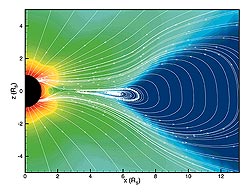Without a magnetic field, the sun would be a bland star with no details, but for nearly 100 years, the origin of this field remains poorly known.
ISSUE #60: WHERE DOES THE SUN'S MAGNETIC FIELD COME FROM?
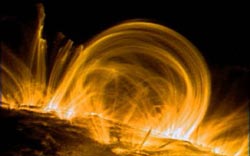
Figure 1: Image of a solar magnetic loops (Courtesy - TRACE).
Statement of the Problem:
The sun, like other stars, formed from a cloud of interstellar gas that probably contained its own magnetic field. But the sun would have lost any remnants of this vestigial magnetic field within a few million years after its formation. Yet today, it has the most powerful magnetic field of any body in the solar system. Through some process, as yet not fully understood, the sun's field must keep regenerating itself across 4.5 billion years of time! How does it do that?
History:
In Issue 52 of TTT, we took a close look at the magnetic properties of the sun. We learned that in 1908, astronomer George Ellery Hale was the first to realize that the features he was seeing on the solar surface had to do with magnetic forces. He found that sunspots could have fields as strong as 1,500 Gauss - nearly 100 times stronger than the general solar magnetic field, and 2000 times stronger than Earth's field at ground-level. Like all magnets, the sun also has its own North-to-South polarity that is more or less lined up with the sun's axis of rotation. When one hemisphere has a south-type polarity, the other hemisphere has a north-type polarity. Over time, Hale realized that the overall magnetic field of the sun changes its polarity North-to-South or South-to-North in step with the 11-year sunspot cycle, but it takes a full 22-years to go through a complete polarity change from North to South and then back again. Astronomers call this the Magnetic Hale Cycle. There are other things about the sun that also rely on magnetism.
Samuel Heinreich Schwabe's 1843 discovery of the 11-year sunspot cycle, Richard Carrington's discovery in 1863 of the differential rotation of the solar surface, and Gustav Spörer's discovery in 1894 of the equatorward migration of sunspots during the cycle (also discovered by Carrington), are the basic properties of solar activity that must be explained by any theory of solar magnetism and its origins.
Primordial Magnetism:
The sun formed from a clouds of interstellar gas that also contained its own magnetic field. This magnetic field would have been trapped by the matter, dragged into the growing sun, and greatly amplified by the time it reached the solar surface. According to evidence from meteorites, this interplanetary magnetic field could have been very strong, perhaps several Gauss in strength according to a study in 1984 by W.H. Ip at the Max Planck Institute. The part of the solar magnetic field we see at the surface, however, can not be a remnant of the ancient field acquired by the sun at the time of its formation. This primordial 'surface field' must have vanished long ago, diffusing back out into space within a few million year. Astronomers know that stars like the sun only a million years old, are very active, and have dense solar winds capable of scouring away the atmospheres of the inner planets. Perhaps the ancient magnetic field was carried off by this solar wind, or by enormous clouds of ejected plasma like the modern Coronal Mass Ejections. In fact, astronomers often see that stars are very active in producing flares and other powerful magnetic 'explosions' during their 'chromospherically-active', formative year, perhaps a glimpse of this ancient magnetic diffusion process which our sun went through.
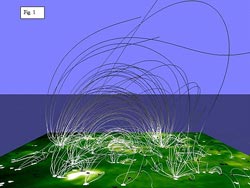
Figure 3: The solar surface is like a magnetic carpet with small fields reconnecting to make larger ones (Courtesy - SOHO).
In some theoretical models, some vestige of this primordial field may still be trapped within the sun's 'Radiative Zone', which lies 100,000 km below the visible surface. How strong might this field be today? According to Nicholas Boruta at the University of Chicago, a variety of evidence, including the data from the SOHO satellite's helioseismometer instrument, prevent the internal magnetic field from being stronger than about 30 Gauss. This is a far cry from the million-gauss fields that were once proposed by astronomers in the '70s and '80s. This field is, however, completely separate from the surface fields because of the unique properties of the plasmas in the Radiative Zone which prevent its escape. So, even the presence of a primordial magnetic field doesn't answer the question of where the sun's surface field comes from/ This is the field that causes sunspots, solar flares, prominences and heats the coronal gasses to millions of degrees C.
The Regenerative Solar Dynamo:
The first idea to resolve this mystery was originally proposed by Larmor in 1919. He suggested that the motions of charged particles in the solar surface could create magnetic fields, just as currents flowing in ordinary wire do. The problem with this idea was found by physicist T.S Cowling who deduced that these 'dynamo fields' could not sustain themselves for long because of the resistance of the solar gases. Like electric currents heating up a copper wire, the resistance of the solar plasma would dissipate the magnetic fields almost as quickly as they tried to form. This problem was so acute that Cowling's idea was referred to as the 'Anti-Dynamo Theorem'.
In 1955, Eugene Parker worked out a complete physical process, now called the 'Parker Solar Dynamo Theory' that could succeed in generating reasonably permanent solar magnetic fields similar to what are observed. The idea was that currents of charged particles in the convective outer layer of the sun would generate magnetic fields, but that these fields would 'float' to the surface. Along the way, they would be cyclonically twisted by the Coriolis Force to form sunspot-like magnetic regions at the surface. These fields would then merge over the course of a full sunspot cycle to form the large-scale solar magnetic field, but with an opposite polarity to its former field. This could, apparently, be a cyclical process resembling the sunspot cycle, although the length of the cycle could not be accurately predicted. This cyclonic twisting was also important because it helped explain how it was that, during the sunspot cycle, the North-South bar magnet 'polar field' is changed into one that looks like the sun sitting in the middle of a magnetic donut (called a toroidal field).
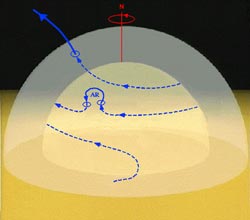
Figure 4: The 'solar dynamo' generates magnetic fields in sunspots from currents of moving plasma beneath the surface (Courtesy: Stanford Solar Center and SOHO).
The Babcock-Leighton Model which was developed in the early 1960's suggested that the differential rotation of the solar surface distorted the magnetic fields and wrapped them more and more tightly, so that sunspots would tend to form at higher solar latitudes at the start of the sunspot cycle, and then shift steadily to lower latitudes as the cycle progressed. The polarity of these sunspot pairs would follow a distinct pattern. If the northern solar hemisphere had a 'north' polarity, the leading sunspot in the sunspot pair would have a south polarity. The reverse would be true in the southern hemisphere. The Babcock-Leighton Model seemed to reproduce all of the observable features of the sunspot cycle, even down to the appearance of individual sunspot pairs. Unfortunately, it could not offer a prediction for the cycle length, nor could it describe in detail just how the surface magnetic field was created in the first place. Also, calculations have shown that the magnetic field cannot be created in the highly-turbulent Convection Zone, nor could it be created in the Radiative Zone!
And the answer is…
There appear to be two separate processes going on. The first process, called the Local Dynamo, has to do with the generation of the small-scale magnetic features on the surface. These are produced by the flows of charged particles in the convecting 'granulation' regions that pock-mark the entire solar surface and create what astronomers call a 'magnetic carpet'.
The Global Dynamo, on the other hand, involves the generation and evolution of the largest features of the sun, such as sunspots, the overall magnetic polarity of the sun, and its long-term changes over the solar activity cycle.
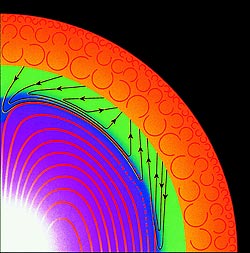
Figure 5: Schematic representation of a magnetic field in the Radiative Zone (red lines); the shearing of part of this field in the Tachocline (green regio nwith black lines) according to one theory of solar magnetism. (Courtesy Gough and McIntyre).
Recent observations of the sun with the SOHO satellite have established the profiles of the flows in the solar interior. In a remarkable study of the 'seismic' properties of the solar surface, astronomers can peer into the interior of the sun just as geologists do with Earth. Just as for Earth's atmosphere, the sun has 'jet streams' and other persistent features. More importantly, the Radiative and Convective Zones can be easily studied in detail. Amazingly enough, although surface gases rotate faster at the equator than at the poles in the Convective Zone (called differential rotation), in the Radiative Zone the gases all rotate in-step as though the sun were a solid body!
In the 1970s solar physicists placed the origin of the solar dynamo in the convection zone, the outer 30 percent of the Sun where its gases boil much like water in a pot on the stove, forming giant cells of rising and falling gases that carry the heat to the surface. But in the early 1980s they realized that features could not persist long enough in this area to act as a dynamo. So attention shifted to the region just below the convection zone
What solar physicists have found is that the differential rotation of the sun has a strong shear in a thin layer at the base of the convective region, called the tachiocline. A 'shear' is a condition in which the speeds of gases change very quickly as you move outwards from the solar interior. It would be like on a freeway where cars in the fast lane are moving faster than in the other lanes. This change in speed (velocity) is called a shear.
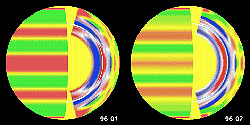
Figure 6: SOHO observations of the Tachocline using helioseismometry data. The inner region shows faster (red) and slower (blue) rotation while in the surface layers red and green are used to show slower and faster. Speed ariations near the base of the convection zone in the Tachocline (the purplish layer) can also be seen. (Courtesy SOHO MDI Experiment).
The Tachocline occupies less than 3% of the solar radius at the base of the Convective Zone and just above the Radiative Zone, like the frosting in the middle of a layer cake. The strong magnetic fields observed in the solar surface must be stored in the Tachocline for a time about equal to the sunspot cycle, because the magnetic fields cannot exist intact in any other location. In the Tachocline, the magnetic fields probably form 'tubes' of force, like the ones required in the Babcock-Leighton Model, but they have to be strong enough so that they can travel through the Convection Zone without being destroyed by the turbulent movements.
With the help of helioseismometry data from SOHO, a team of Stanford scientists has narrowed the search for this region to a layer 38,000 miles thick and centered at a depth of about 135,000 miles below the solar surface. The data show that the shear layer is sharper and does not extend into the convection zone as suggested by ground-based measurements. Also, the data indicate that sound waves speed up more than expected in this region, indicating that the turbulence and mixing associated with a dynamo are present.
There are still many details to be worked out, such as how do the intense magnetic flux ropes form and remain stable as they float up to the surface, but solar physicists now almost universally adopt the solar dynamo as their working theory for the origins of solar magnetism.
Credits:
- Dr. John Mariska (Hinode)
- Dr. Gordon Holman (RHESSI)
- Dr. Sten Odenwald (Author)
GALLERY
REFERENCES
W. Ip ,1984 'Magnetic field amplification in the solar nebula', Nature v. 312, p. 625.
D. O. Gough and M. E. McIntyre, 1998, 'The inevitability of a magnetic field in the sun's radiative interior', Nature 394, 755-757(20 August 1998)
Nicholas Boruta ,1996, 'Solar dynamo surface waves in the presence of a primordial magnetic field: A 30 Gauss upper limit in the solar core', The Astrophysical Journal, V. 458, pp. 832-849.
Alexander Friedland and Andrei Gruzinov, 2004, 'Bounds on the magnetic fields in the radiative zone of the sun', The Astrophysical Journal, v. 601, pp.570-576.
2008 ISSUES
- #63: Eclipse
- #62: Where is the heliopause?
- #61: What causes and Auroral Storm?
- #60: Where does the Sun's magnetic field come from?
- #59: Where did all the Neutrinos go?
- #58: Why is the Sun's Corona Hot?
View past issues
Space Weather Fact
Toy 'rare-earth' magnets can be 5 times stronger that a sunspot magnetic field.


